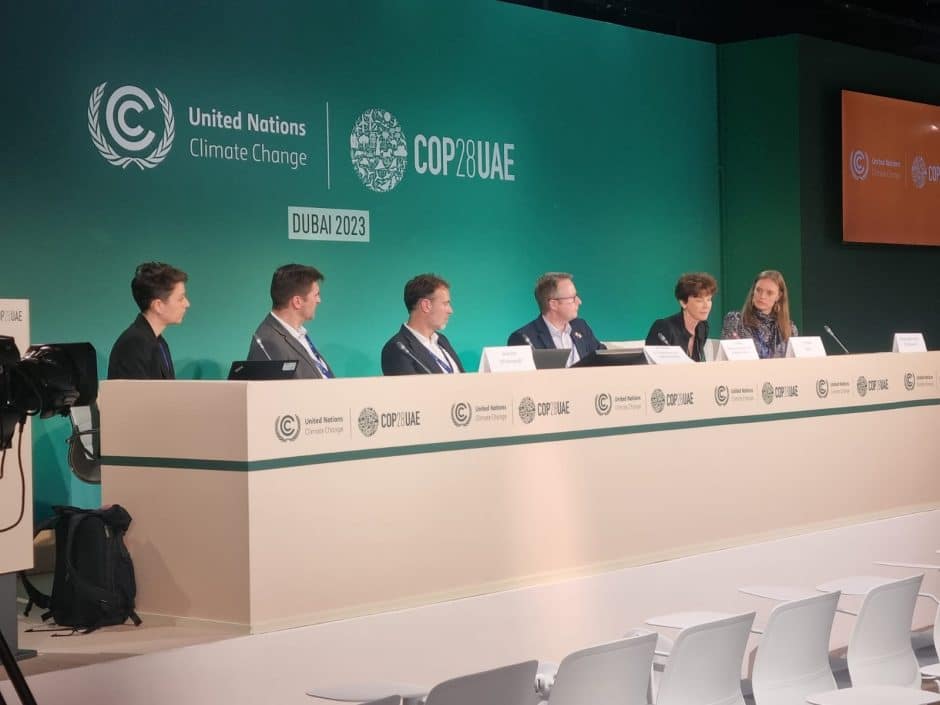Beyond the pledges: Bridging the implementation, finance and capacity gaps

Central to the Paris Agreement was the commitment of each country to track and report on its environmental efforts, and to assess and report on overall progress every five years with a global stocktake. Now countries need to work on bridging the gap between their climate ambition and the reality.
The first-ever stocktake is set to conclude during COP28. It will inform the next round of nationally determined contributions (‘NDCs’), to be put forward by 2025. The stocktake can help policymakers and stakeholders strengthen their climate policies and commitments in their next round of NDCs, paving the way for accelerated action.
But while the Paris Agreement has inspired climate action all around the world, the current trajectory of global emissions is far from consistent with limiting the global temperature rise to 1.5°C, and similarly, adaptation to climate change is nowhere near the levels needed, mainly due to the lack of finance.
In addition to that, there is a well-known gap between the pledges that countries are making every day since the opening of COP28 in Dubai, and the reality of implementation, finance mobilisation and capacity building.
Place-based innovation: local communities as hubs of experimentation
Key to bridging this gap is the need for systems transformation, which follows a whole-society and whole-economy approach that mainstreams climate resilience and development aligned with low greenhouse gas emissions.
Speaking at Climate KIC’s press conference at COP28, Andy Kerr, Chief Strategy Officer at Climate KIC, said: “These are not challenges that can be solved in the negotiating rooms of COP. This is where the rubber hits the road. This is about working in places with people and their livelihoods and how we make change happen. From our perspective, innovation is absolutely essential. We see people trying to impose solutions on local communities which are simply not flying. We have to match supply and demand, and we have to build capabilities.”
There are already concrete examples that put this systems transformation theory into practice. One example is the EU Mission on Climate-Neutral and Smart Cities, a Horizon Europe programme, that aims to help 100 European cities become climate-neutral and smart by 2030 and to ensure that they act as experimentation and innovation hubs to enable all European cities to follow suit by 2050. Climate KIC plays a central role in implementing the Cities Mission by leading its flagship project NetZeroCities.
Jorn Verbeeck, Board Member of the EU Cities Mission, said: “It’s about landing something in that ‘messy middle’, to embrace the complexity. We need to see the cities as a living ecosystem, bottom-up and top-down, full of hope and experimentation to constantly reinvent the urban ecosystem and to adapt to a changing environment. How do we do that? Many of the solutions are available, but we need to get to the common language, to those common building blocks. Crucial in this journey is to invite cities, regions and national governments to work together, and to use regulation, ambition and incentives to build accountability to urban stakeholders.”
Orchestrating bottom-up ideas into ambitious country-wide frameworks
Another example of place-based innovation is the Deep Demonstration partnership between Climate KIC and Ireland’s Department of Agriculture, Food, and the Marine, which is supporting the entire Irish land and agri-food value chain to identify and implement sustainable practices, so that farmers and rural communities can thrive and agri-food and bio-based industries can transition to sustainable business models, all while meeting challenging climate targets.
Liam Brennan, Agricultural Inspector at the Department of Agriculture, Food and the Marine of Ireland, said: “Our two-year partnership with Climate KIC engaged many stakeholders across the sector, and we mapped out all the interlinkages that exist in the system. So we are gathering these ideas about how we can accelerate the pace towards our climate targets – also by exchanging with other countries.”
He added: “We managed to group those approximately 280+ ideas into seven flagship areas – such as circular bio-economy, carbon farming, sustainable beef and dairy, tillage and investment in new industry value chains. We hope to continue our partnership with Climate KIC, bringing in funding and activating these flagships, and really start progressing towards our climate targets.”
From linear innovation to embracing complex learning and systems thinking
The Organisation for the Economic Co-operation and Development (OECD) is also working across the board to bring systems thinking and systems innovation to the heart of climate action and explore new and radical ways of working across funding and implementation to mobilise climate finance more effectively.
“Different governments have taken extremely different approaches,” said Jo Tyndall, Director for Environment at the OECD. “Climate change has been now mainstreamed across whole organisations and is being addressed from multiple perspectives. The OECD has taken the view that we need to pull all these different threads together through systems thinking, by looking at ‘positive tipping points’, or the actions and approaches that can really accelerate the downward curve to reduce emissions.” Tyndall mentioned two key enablers: implementation of good, clear and credible policies, and unlocking finance from multiple sources.
Often underestimated is the capacity gap between the pledges that countries, regions, cities and industries make and what they can achieve. Closing Climate KIC’s press conference at COP28, Solveig Zophoniasdottir, Head of Learning at Climate KIC, said: “In our almost 15 years of history, we have learnt that our innovation efforts are making progress. But we need to link those, moving from a linear sector-to-sector approach to actively designing innovation across ecosystems and portfolios, because we can see that by that, we can accelerate and transform faster”.
She added: “We are in a massive learning curve. Let’s focus on building the appetite for learning and upskilling through messy collaborations and complexity, to be able to innovate together, instead of seeking safe spaces.”
Watch the recording here:
Contact us at media@climate-kic.org if you have any questions.
